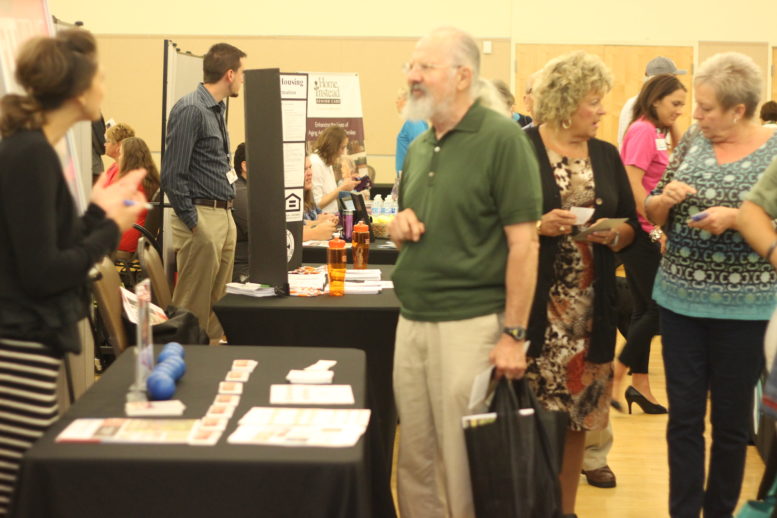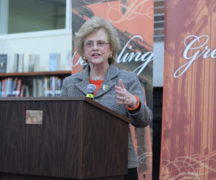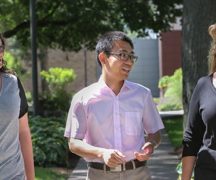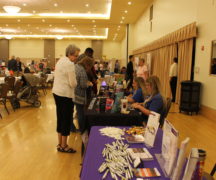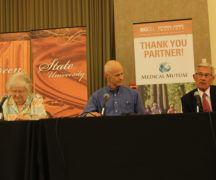By DAVID DUPONT
BG Independent News
Speaking from 400 miles away in upstate New York, Esther Greenhouse, struck a nerve with those watching her in Bowling Green.
The environmental gerontologist was the keynote speaker at the Optimal Aging Community Fair at Bowling Green State University. Greenhouse projected an image of a parking meter kiosk as an example of poor design. You could almost hear the local audience groan. The City of Bowling Green installed such meters to considerable complaint.
Throughout her presentation, Greenhouse talked and showed images that could have come from just a few miles away: Four-lane roads that are hard to cross; old houses that require steps to enter; showers that require climbing into; sidewalks in poor repair; and rural roads with no sidewalks.
And when she took questions, those in the audience zeroed in on precisely those issues – rural transportation, roundabouts, and parking kiosks.
The problem with so many of these issues of public space, Greenhouse said, is that our built environment is designed for people driving vehicles. A small town has roads made so trucks can easily negotiate it, not so people can walk safely.
“We’ve put all out transportation eggs in one basket, vehicular traffic, primarily vehicles with one person in them,” Greenhouse said.
Those environments discourage people with limitations, whether age, disability, or logistical, from going out. And that makes their problems even worse.
“The status quo is not benign,” she said. “We do not design for everyone.”
It discourages elders from getting out, making it harder for them to get the exercise, healthy food, and the social interaction they need. These kind of environments, paired with poorly designed homes, make it harder for people to age in place.
Over and over Greenhouse asserted that such issues don’t only hurt the elderly and those with disabilities, but are problems for parents pushing strollers or people pulling luggage.
Pedestrian “refuges,” where they can wait to finish crossing the street are helpful. In this regard roundabouts could be an improvement, she said.
It’s not only the public built environment that’s problematic. Even places designed for older adults have problems, such as doors that are too narrow for wheelchairs, no first-floor toilet, and stairways that lack two banisters or are poorly lit.
Removing these obstacles benefit someone who has trouble walking, but also someone carrying a child or a basket of laundry.
Greenhouse cited the lever door handle as a feature that works better for everyone than the standard round door knob.
Greenhouse noted that 80 percent of adults will “age in place,” but communities often don’t have the appropriate housing stock or services to meet their needs.
During a separate afternoon session, Greenhouse led about 30 conference attendees in a brainstorming exercises to study the conditions locally.
The attendees, themselves retirees, business people, community residents and officials, looked at issues such as access to healthy food, transportation, social opportunities, and housing. In the end, they were asked to rank those issues they considered the top priorities.
Transportation issues were seen as the top priority. A rural county posing particular problems in this regard. The second top priority was better communication about all the programs that exist to help older adults. The third was adequate housing.
These issues are especially pressing given the aging population. In 2000, there were 35 million Americans 65 or older. By 2030, that will have more than doubled to 72.1 million. By 2032, the AARP estimates Americans 50 and older will be responsible for 52 percent of the Gross Domestic Product and pay $740 billion in state and local taxes.
In designing an environment, she said officials need to make sure they are getting input from all parties involved. That would help avoid trying after the fact to figure out how to deal with flawed design.
This is the second year the Optimal Aging Community Fair has been presented by BGSU’s Optimal Aging Institute. In addition to discussions and speakers, there were displays from about 40 businesses and agencies.

